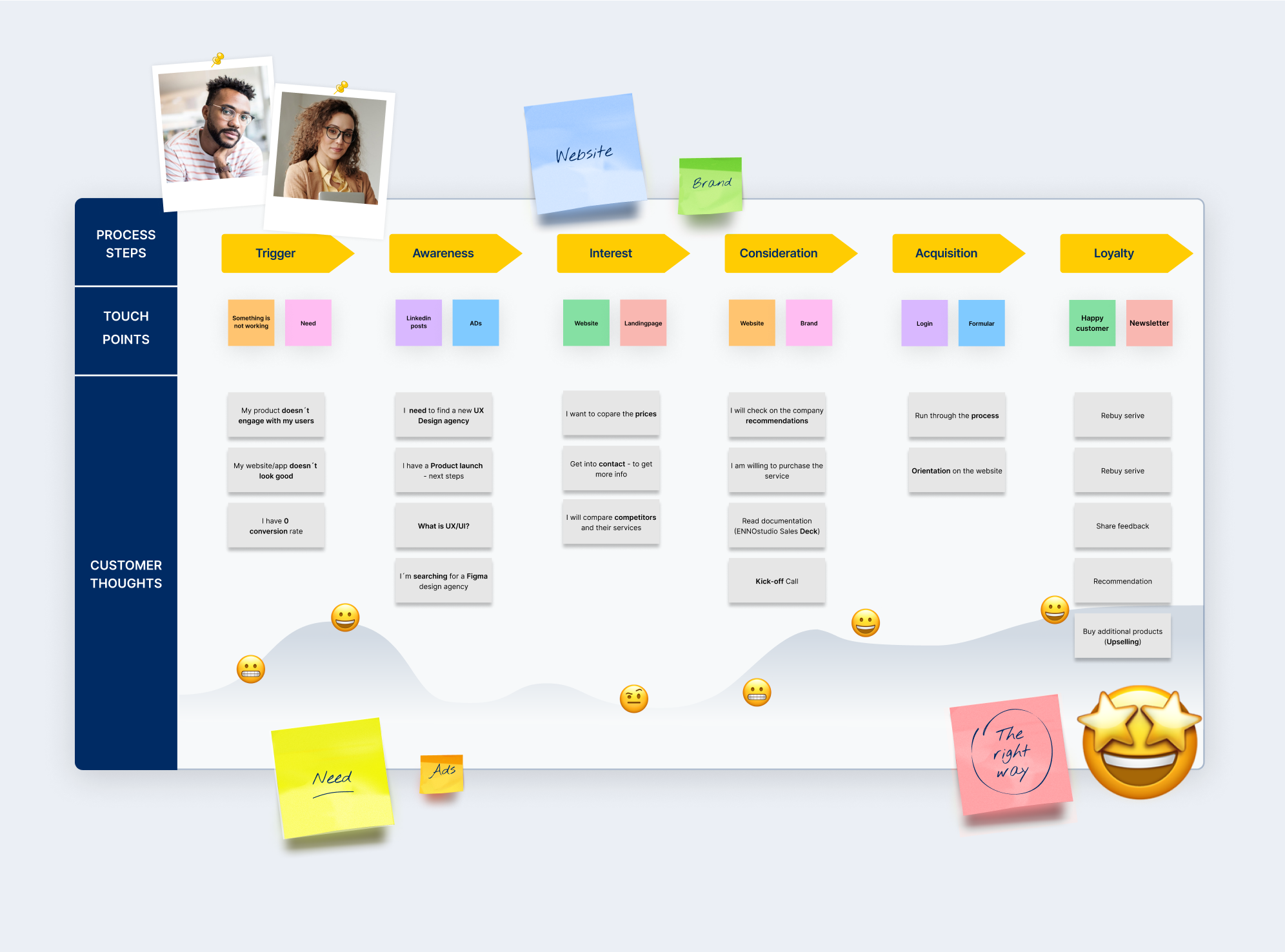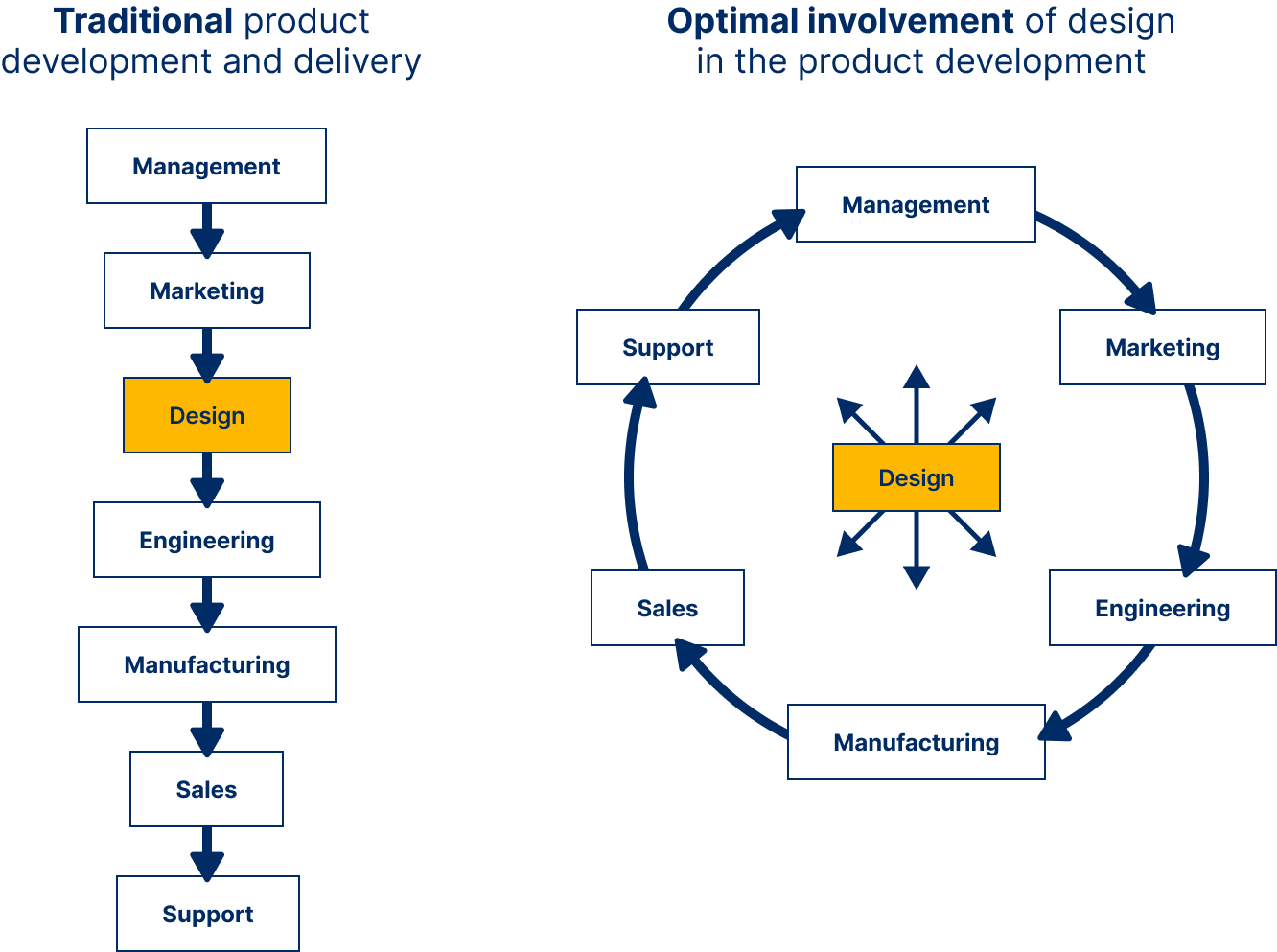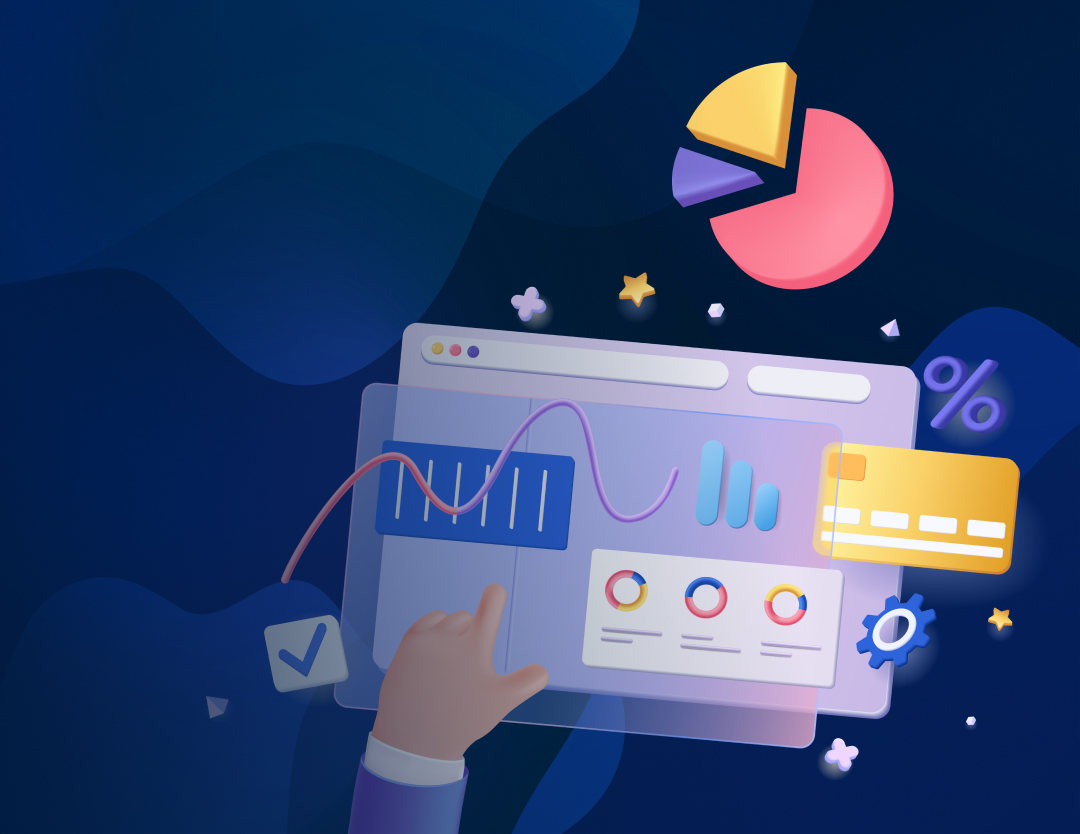Design insight
Design-Led Transformation: Bridging the Gap Between Taylorism and the Digital Age.
Scientific Management: The birth of efficiency and the data-driven work environment
One of the main challenges of the digital era is understanding human needs and expectations in relation to complex products. Yet our approach is often fact-based and data-driven. A human-centric approach can be a solution to this issue.
Designers have a history of putting the user at the center of their creations. And in today’s world of hyper-Taylorism this is vital. Find out in this article how human-centric delivers exactly what customers want and why.
At the end of the 19th century, a foreman called Frederick Taylor was “constantly impressed by the failure of his [team members] to produce more than about one-third of [what he deemed] a good day’s work”. So he set out to discover, by scientific methods, how long it should actually take men to perform each task they were given. He began putting the first elements of scientific management into operation in late 1882. And this, basically, is when and how scientific management or Taylorism was born. It is deemed to be one of the earliest approaches to organizing work and improving productivity in an industrial setting.
Scientific management has five main principles:
- Time and motion studies – Taylor believed that work processes can be optimized by carefully studying and analyzing each task’s motions and eliminating unnecessary movements. This involves breaking down tasks into small, repetitive steps and finding the most efficient way to perform them.
- Standardization – Taylor emphasized the importance of developing standardized methods of work that are to be adhered to by all employees. Organizations can reduce variability and increase efficiency when they standardize processes.
- Division of labor – Taylor advocated for a clear division of labor between workers and managers. Managers are responsible for planning and organizing work, while workers are expected to follow prescribed methods without deviation.
- Incentive and piece-rate (piece work) systems – Taylor proposed that workers should be paid based on their individual performance. He introduced piece-rate systems, where workers are compensated based on the number of units they produce, which incentivizes them to work more efficiently to earn more.
- Training and development – It is important to train workers to perform tasks according to set methods. Taylor believed this leads to higher productivity and a reduction in waste.
The goal of Taylorism is to maximize productivity and efficiency in the workplace by applying a systematic approach to managing and organizing work. While it has led to significant improvements in productivity, Taylorism has also been criticised for its focus on task efficiency at the expense of worker satisfaction, creativity and general well-being. The result is that, over time, management theories and practices have evolved. They are leaning toward a more holistic view of the workplace and to consider efficiency while also taking into account human factors.
The Technological Revolution: Data-driven performance is a digital continuation of Taylorism
The digital revolution has been influenced by scientific management through its continued emphasis on efficiency, optimization and data-driven decision-making. Like scientific management, the digital revolution seeks to streamline processes, standardize workflows and enhance productivity. Moreover, the use of data analytics and automation mirrors Taylorism’s use of time and motion studies to inform and improve work practices. Despite advancements in technology and broader considerations with regard to user experience, the foundational principles of scientific management – efficiency and effectiveness – are still paramount in the digital age.

If this new form of Taylorism is motivated by a search for efficiency, it may actually exert a greater degree of control over workers. This raises concerns about welfare at work in the digital economy. It is something investigative journalist Christian Parenti highlighted in an article published in American left-wing newspaper, The Nation, in 2001, titled: “Big Brother’s Corporate Cousin”. He pointed to a new management method based on the digital revolution where, “computers, databases and high-speed networks are pushing social relations on the job toward a new digital Taylorism where every motion is watched, studied and controlled by and for the boss”. He added that it left us with the philosophical question of the relationship between technology and freedom.
From Efficiency to Empathy: Human-centric design as a solution to the constraints of Taylorism
Human-centric design offers a compelling response to the perceived limits of scientific management. It prioritizes the needs, experiences and well-being of individuals. Unlike scientific management’s focus on efficiency and standardization, human-centric design emphasizes empathy and understanding; involving users in the design process to ensure solutions are relevant and useful. It addresses Taylorism’s potential neglect of worker satisfaction by taking into account the overall user experience, also fostering creativity and promoting iterative design as a basis for continuous improvement. By recognizing human factors, human-centric design creates solutions that are more balanced, inclusive and meaningful. In doing so, it offers a more holistic approach to managing and organizing work in modern contexts.
There are a number of well-established aspects of human-centric design, including:
- Empathy and understanding – Human-centric design starts with an empathetic understanding of the people who will be using or affected by the offered products, services or systems. Designers gain insights into their needs, pain points and aspirations by engaging with this target audience and conducting user research, which allows for the creation of solutions that are relevant and useful.
- Co-creation and collaboration – Unlike Taylorism, which often imposes top-down solutions on workers, human-centric design involves users in the design process. Designers collaborate with end-users, workers and other stakeholders to ensure that their perspectives are considered, which ultimately leads to solutions that are more inclusive and better aligned to actual needs.
- Focus on user experience – Taylorism tends to prioritize task efficiency, without necessarily considering the overall user experience of the workers. Human-centric design, on the other hand, places a strong emphasis on creating positive and meaningful user experiences. This encompasses efficient processes, but at the same time also gives consideration to user satisfaction, motivation and well-being.
- Iterative design and continuous improvement – Human-centric design embraces an iterative approach, allowing for ongoing feedback and improvement on designs. In this way, solutions are continually refined based on real-world feedback and changing user needs, so ensuring that they remain relevant and effective over time.
- Holistic consideration of human factors – Human-centric design takes into account various human factors, including cognitive abilities, emotions, physical capabilities and social dynamics. It creates more rounded and sustainable solutions by considering the holistic needs of individuals, teams and organizations.
- Emphasis on creativity and innovation – Taylorism’s standardized and rigid approach can stifle creativity and innovation. In contrast, human-centric design encourages creativity and unconventional thinking that empowers and encourages designers and workers to explore new ideas and approaches.
Overall, human-centric design offers a more people-oriented and adaptive approach to problem-solving. And by putting people at the center of the design process, human-centric design creates solutions that are not only efficient and effective but also – for the people who engage with them – meaningful, enjoyable and impactful.
Creative Drivers: Designers can have a dramatic effect on the direction of an organization
Having individuals with design backgrounds leading digital projects is crucial. They act as guardians of user expectations and needs, ensuring an even approach that integrates technology and performance with human factors.
Designers are not always viewed this way in traditional organizational set-ups. Take the template of the Double Diamond model (below). Here we see that in traditional organizations, designers are normally only involved during its second part: the execution of the creative brief. They, therefore, work to a set of processes provided for them, by people who aren’t them; primarily, people who are not creatives and don’t think as such.

However, this must change, because organizations are missing out on so much by not including designers from the onset of any project. In reality, they should be there when the first letter is scribbled down in the first meeting. And that is because the ‘left-brained’ (analytical) approach – as opposed to the ‘right brained’ (holistic) one – with its segmenting, surveying and sizing of each step in the production process, seems sticky and unproductive in the connected services economy. This static analytic focus on Cost of Goods Sold (COGS) and the Four Ps for the Marketing Mix (Product, Price, Promotion, and Place) is a problem in need of a modern solution. Time to bring designers into the fold much earlier so that they can offer their more dynamic approach and create an organizational-wide, human-centric approach with a common focus.
If you want to learn more about how to do this and about design thinking in general, we offer informative workshops and training that will definitely help your organization become more human-centric and inclusive.
Inclusive by Design: Designers don’t impose their ideas but match them to the needs of the user
But what have designers got that works in the connected services economy? Why exactly are they a solution? It’s really about human relationships. And one of the core characteristics that connects us as humans – empathy. And any designer worth their salt exhibits empathy by the sheer act of bringing the customer into the decision-making process.
It seems the most common sense idea but many setting the agenda, creating the brief, have been slow to consider it, let alone incorporate it at all. And yet is it proven to work in the digital age. For example, creating personas to template customers. At Airbnb, extensive user research was done at the very start of the project to build deep personas for Hosts and Guests. They included the customer journeys of both. An illustrator from Pixar was then engaged to add their touch to key moments in the journey in the form of storyboards. These created a single, visually readable and workable goal for design, engineering and other interested parties to work toward from the outset of the project.

Design can also help when creating strategies for untested markets too. When strategy focuses on optimization, a set of metrics, such as bettering conversion rates or increasing engagement is stated. And when we talk about delivering products to market segments, directives come in the form lists of features and services targeted at audiences. This works because it deals with a known element. However, when it’s about new offerings for an uncertain market context, these standard, inert approaches fail to get it right. They actually give rise to four clear problems.
Firstly, each stakeholder understands the strategy differently, which only often manifests itself at a time when it is too late to resolve. Secondly, the product or service being developed doesn’t align with what the stakeholder envisioned, leading to real disappointment. Thirdly, internal teams lack motivation when working to abstract figures, rather than clear visualised goals and, as a result, may deliver impassioned work that meets the requirements but does not go that extra mile. Lastly, the strategy might be unworkable because the requirements are compromised by conflicts, inter-department jealousies or bruised egos.

Designers don’t work that way. At each step they bring user research, sketching, ideation, and rapid prototyping into the strategy. When these are employed in the agenda-setting phase of the project they can cut the aforementioned standard approach issues off at the pass. For instance, low fidelity sketches can soon expose shortcomings in an incoherent or inconsistent strategy. Indeed, by making a strategy concrete and whole and moving in the direction of a single guiding ‘North Star’, you ensure that all stakeholders have a shared understanding of the negative effects, often very costly, of deviating from the strategy.
The great thing about finding a problem early – as happens with iteration – is that you never have one of those ‘what is going on’ meetings. The ones where everyone is looking at each other wondering how it happened that what is being or has been developed is totally different to what was expected. Cue in-fighting. Cue project back to square 1. Cue ages to get the team around the same table again. And believe it or not, cue repeating the whole problem over again because designers with their holistic approach were still not brought on board earlier.
We’ve got it Covered: Designers can bring all departments into the fold
So, yes, designers should not only contribute to strategy but they should actively shape it. By doing so they can inform the work of all those involved in product planning, development and realization.
The traditional model (above) closes the door on designers, or rather doesn’t open it to them until later in the process. This is counterproductive because designers, as creatives, employ divergent thinking to explore a range of options, dipping their toes in and out of them, and gently exposing customers to them at each step in the process to gauge if they are welcomed. In this way, design brings forth surprising solutions. And it does so in such a way that it collects vital external feedback that can inform all company departments. So, when this happens, design acts as a third beneficial pillar – along with technology and business efficiency – with regard to the development and getting to market of a product or service.

Historically, the ultimate authority in product development has rested with someone representing “the business” pillar, such as product marketing, general managers, or product managers. These people identify the market need, set down a set of requirements and put them in the hands of a team to build to. But continuous software delivery requires changes to this team dynamic. For software products, the technology has become too complex to be the responsibility of a single product manager. To deliver quality work you need authority in the hands of a decision-maker with plenty of technical know-how.
Diving Deeper: The modern consumer needs to feel they are understood
So, with this in mind, teams with leadership from product and engineering are now a thing. But in this world of connected software and services more is required. Quality user experience cannot be addressed through technical and business expertise alone. It needs to be ‘humanised’, for want of a better word, as in this inclusive new world, empathy equals understanding of the new market and its more complex customer expectations. These consumers want you to know them and be authentic about it. They will leave you instantly if they see you as rigid and out-of-touch with their views. The reality of contemporary product and service delivery is a complex one, and needs the three-pronged business, technology and design approach. So, designers should no longer be handed briefs and rigid requirements, but instead be part of the process from the get go. Once they are, once they help create that single North Star, then the benefits will follow on many fronts, not least the financial one.
If you want to know more about how to improve your experience, please feel free to get in touch with us.

We are a design and innovation studio creating engaging, accessible digital experiences for everyone. Our team of product designers and strategic consultants combine beautiful design and creative strategies to build and promote user interfaces that make a real difference to people’s lives.
